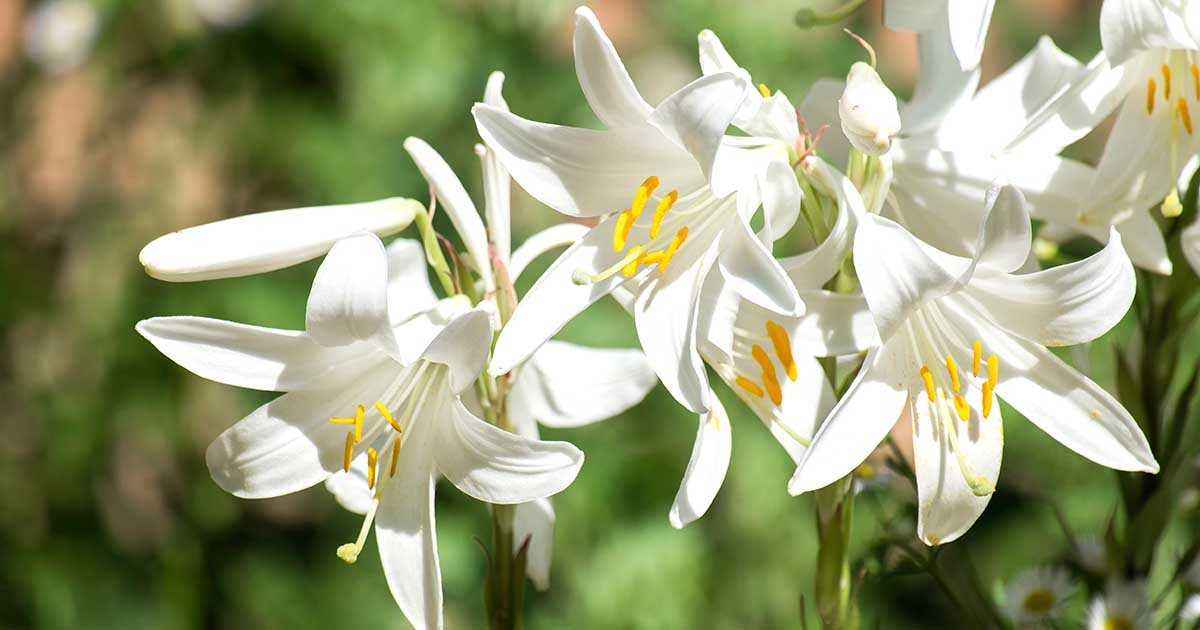- Types of Lily Varieties
- 1. Asiatic Lilies
- 2. Oriental Lilies
- 3. Trumpet Lilies
- 4. Tiger Lilies
- 5. Daylilies
- 6. Easter Lilies
- 7. Martagon Lilies
- 8. Asiatic Hybrid Lilies
- Choosing the Right Lily Varieties for Your Garden
- Consider the Growing Conditions
- Choose the Right Height
- Decide on the Flower Form
- Choose the Right Colors
- Consider the Fragrance
- Consult a Planting Guide
- Lily Care: Essential Tips for Successful Growing
- 1. Choose the Right Location
- 2. Prepare the Soil
- 3. Plant at the Right Time
- 4. Water Thoroughly
- 5. Fertilize Regularly
- 6. Stake Tall Varieties
- 7. Remove Spent Flowers
- 8. Protect from Pests and Diseases
- 9. Prepare for Winter
- Creating the Perfect Growing Environment for Lilies
- Choosing the Right Location
- Preparing the Soil
- Adding Organic Matter
- Planting the Lilies
- Providing Adequate Water
- Mulching and Fertilizing
- Protecting from Pests and Diseases
- Common Diseases and Pests Affecting Lily Varieties
- Fungal Diseases
- Viral Diseases
- Pests
- Harvesting and Storing Lily Bulbs
- 1. Choosing the Right Time
- 2. Preparing the Bulbs
- 3. Cleaning the Bulbs
- 4. Drying the Bulbs
- 5. Storing the Bulbs
- 6. Checking for Rot
- 7. Replanting the Bulbs
- Questions and Answers:
- What are the different types of lilies?
- What is the difference between Asiatic and Oriental lilies?
- How do I care for lilies?
- Can lilies grow in pots?
- Do lilies attract bees?
- How long do lilies bloom?
- Can lilies be grown from seeds?
- Videos: HOW TO GROW LILIES IN POTS – Adam’s favourite lilies and how to grow them
With their elegant shape and beautiful colors, lilies are a favorite flower for many gardeners. These stunning blooms come in a wide variety of types, making it easy to find one that suits a specific taste or garden style. In this ultimate guide, we will explore the different types of lilies, their care requirements, and tips for successfully growing these wonderful flowers.
One of the most popular types of lilies is the Asiatic Lily. Known for their vibrant and bold colors, Asiatic Lilies are ideal for adding a pop of color to any garden. These lilies are easy to grow and require minimal maintenance, making them a great choice for beginner gardeners. With their compact size and sturdy stems, Asiatic Lilies are also an excellent option for container gardening.
If you prefer a more fragrant variety, Oriental Lilies are a perfect choice. These lilies are known for their strong, sweet scent that can fill the entire garden. Oriental Lilies come in a wide range of colors, from pure white to deep red, and their large blooms make a statement in any floral arrangement. However, it’s important to note that Oriental Lilies require a bit more care compared to other varieties, as they prefer a slightly acidic soil and regular watering.
For those who love the classic beauty of white flowers, the Easter Lily is a must-have. With their pure white petals and trumpet-shaped blooms, Easter Lilies symbolize purity and rebirth. These lilies are often associated with religious celebrations, particularly Easter, but they are also valued for their elegant appearance. Easter Lilies require a well-draining soil and regular watering to thrive.
“Lilies are a favorite flower for many gardeners, thanks to their elegant shape and beautiful colors.”
When it comes to caring for lilies, proper planting and maintenance techniques are essential. Lilies should be planted in well-draining soil that is rich in organic matter. They prefer a location with full sunlight or light shade, and regular watering is necessary to keep the soil moist but not waterlogged. It’s also important to remove any spent flowers to encourage continuous blooming and prevent the development of seed pods.
Overall, growing lilies can be a rewarding experience for gardeners of all levels. Whether you choose Asiatic Lilies, Oriental Lilies, or the classic Easter Lily, these flowers are sure to add beauty and elegance to any garden or floral arrangement. By following the care tips mentioned in this guide and selecting the right variety for your preferences, you can enjoy the beauty of lilies all season long.
Types of Lily Varieties
Lilies come in a wide range of varieties, each with its own unique characteristics and beauty. Here are some of the most popular types of lilies:
1. Asiatic Lilies
Asiatic lilies are known for their vibrant colors and wide range of hues. They are early bloomers and are often the first lilies to flower in the summer. These lilies have an upright growth habit and their flowers can be upward-facing or outward-facing.
2. Oriental Lilies
Oriental lilies are known for their large, fragrant blooms. They come in a variety of colors and their flowers can be upward-facing or outward-facing. Oriental lilies are later bloomers and usually start flowering in mid to late summer.
3. Trumpet Lilies
Trumpet lilies, also known as Aurelian lilies, have trumpet-shaped flowers with an elegant fragrance. These lilies are tall and can reach heights of up to 6 feet. They generally bloom in mid to late summer and come in shades of white, yellow, and orange.
4. Tiger Lilies
Tiger lilies are easily recognizable by their large, fiery orange flowers with dark spots. These lilies have a unique appearance and add a bold splash of color to any garden. Tiger lilies bloom in mid to late summer and are quite hardy.
5. Daylilies
Daylilies are not true lilies, but they are often grouped with lilies due to their similar appearance. These flowers have a wide range of colors and their blooms only last for one day. However, daylilies produce multiple flowers on each stem, ensuring a continuous display of color throughout the summer.
6. Easter Lilies
Easter lilies are popular in the springtime due to their pure white flowers and sweet fragrance. These lilies are associated with the religious holiday and are commonly used in home decor during Easter. Easter lilies bloom in late spring to early summer.
7. Martagon Lilies
Martagon lilies are known for their turk’s cap-shaped flowers and their ability to naturalize in the garden. These lilies have delicate, pendulous blooms that come in shades of pink, white, and purple. Martagon lilies bloom in mid to late summer and prefer partially shaded areas.
8. Asiatic Hybrid Lilies
Asiatic hybrid lilies are a cross between Asiatic lilies and another lily variety. These hybrids combine the vibrant colors of Asiatic lilies with the unique characteristics of the other lily variety. They come in a wide range of colors and bloom in early to mid-summer.
| Type of Lily | Botanical Name |
|---|---|
| Asiatic Lily | Lilium asiaticum |
| Oriental Lily | Lilium orientalis |
| Trumpet Lily | Lilium regale |
| Tiger Lily | Lilium lancifolium |
| Daylily | Hemerocallis spp. |
| Easter Lily | Lilium longiflorum |
| Martagon Lily | Lilium martagon |
| Asiatic Hybrid Lily | Various hybrids |
Choosing the Right Lily Varieties for Your Garden
Lilies are a beautiful addition to any garden, with their vibrant colors and elegant blooms. With so many varieties to choose from, it can be overwhelming to decide which ones to plant in your garden. Here are some tips to help you choose the right lily varieties:
Consider the Growing Conditions
Before choosing a lily variety, it’s important to consider the growing conditions in your garden. Lilies prefer well-drained soil and full sunlight, although some varieties can tolerate partial shade. Make sure to choose varieties that are suitable for your climate and hardiness zone.
Choose the Right Height
Lilies come in a range of heights, from dwarf varieties that reach only a few inches tall to towering varieties that can grow up to 6 feet or more. Consider the overall height of the plants in your garden and choose lilies that will complement the rest of your flowers.
Decide on the Flower Form

Lily flowers come in a variety of shapes and forms. Some have large, open blooms with reflexed petals, while others have smaller, more intricate flowers. Consider the overall aesthetic of your garden and choose lilies that will fit in with the other flowers.
Choose the Right Colors

Lilies are available in a wide range of colors, from pure white to deep red and everything in between. Consider the color scheme of your garden and choose lilies that will complement the other flowers. You can also mix and match different colors for a more vibrant display.
Consider the Fragrance
Some lily varieties are highly fragrant, while others have little to no scent. If you enjoy the fragrance of flowers, consider choosing varieties with a strong scent. However, keep in mind that strongly scented lilies may attract more insects, so make sure to plant them away from sitting areas.
Consult a Planting Guide
If you’re still unsure which lily varieties to choose, consult a planting guide or ask for advice from a local gardening expert. They will be able to provide recommendations based on your specific growing conditions and preferences.
By considering the growing conditions, height, flower form, colors, fragrance, and consulting a planting guide, you can choose the right lily varieties for your garden and create a stunning display of color and beauty.
Lily Care: Essential Tips for Successful Growing
1. Choose the Right Location
It’s important to choose a location with plenty of sunlight for your lilies. Most lily varieties require at least six hours of direct sunlight each day. Additionally, ensure that the soil is well-draining to prevent waterlogging and root rot.
2. Prepare the Soil
Before planting your lilies, prepare the soil by removing any weeds or grass. Loosen the soil to a depth of about 12 inches and mix in organic matter such as compost or well-rotted manure. This will help improve drainage and provide essential nutrients for healthy growth.
3. Plant at the Right Time
Lilies are generally planted in spring or autumn. The exact timing can vary depending on your climate and the specific variety of lily you are growing. Plant bulbs at a depth of three times their height, with the pointed end facing up.
4. Water Thoroughly
Water your lilies thoroughly after planting and during periods of dry weather. Aim to keep the soil evenly moist but not waterlogged. Avoid overhead watering, as lily leaves and flowers can be susceptible to fungal diseases.
5. Fertilize Regularly
Feed your lilies with a balanced fertilizer every four to six weeks during the growing season. Avoid using high-nitrogen fertilizers, as this can promote excessive foliage growth at the expense of flowers. Follow the manufacturer’s instructions for application rates.
6. Stake Tall Varieties
If you are growing tall lily varieties, such as Oriental or Trumpet lilies, it is advisable to stake them to prevent them from toppling over in strong winds or heavy rain. Use bamboo stakes or other suitable supports and secure the stems gently to avoid damaging them.
7. Remove Spent Flowers
To prolong the flowering period and encourage more blooms, remove spent flowers by cutting them off just above the next set of leaves or buds. This will also help redirect the plant’s energy towards bulb development.
8. Protect from Pests and Diseases
Watch out for common lily pests such as aphids, slugs, and snails. Use organic insecticides or handpick these pests to prevent damage. Additionally, keep an eye out for fungal diseases such as gray mold or lily leaf spot. Remove any infected foliage and treat with a suitable fungicide if necessary.
9. Prepare for Winter
In colder climates, lilies may require some protection during the winter months. Apply a layer of mulch around the base of the plants to insulate the bulbs from freezing temperatures. Remove the mulch in spring once the danger of frost has passed.
Following these essential care tips will help ensure that your lilies thrive and continue to delight you with their beautiful flowers year after year.
Creating the Perfect Growing Environment for Lilies
Choosing the Right Location
The first step to creating the perfect growing environment for lilies is choosing the right location. Lilies thrive in full sunlight, so it’s important to select a spot that receives at least 6-8 hours of direct sunlight each day. Additionally, lilies prefer well-draining soil, so choose a location with soil that is loose and well-aerated.
Preparing the Soil
Before planting lilies, it’s essential to prepare the soil to provide the best growing conditions. Start by removing any weeds or grass from the area where you plan to plant the lilies. Then, loosen the soil using a garden fork or tiller to a depth of 12-14 inches. This will help improve drainage and allow the lily bulbs to establish strong roots.
Adding Organic Matter
Adding organic matter to the soil can greatly benefit the growth and development of lilies. Mix in compost or well-rotted manure to improve the soil’s fertility and water-holding capacity. This will provide the lilies with the necessary nutrients for healthy growth and vibrant blooms.
Planting the Lilies

When planting lilies, make sure to space them at least 8-12 inches apart to allow for proper air circulation. Dig a hole that is deep enough to accommodate the lily bulb, usually around 6-8 inches. Place the bulb in the hole, with the pointed end facing up, and cover it with soil. Give the bulb a gentle press to ensure good soil contact.
Providing Adequate Water
Water is essential for the growth of lilies, especially during their active growing season. Water the lilies deeply, ensuring that the soil is evenly moist but not waterlogged. A general rule of thumb is to provide about 1 inch of water per week, either through rainfall or irrigation. Be sure to water the lilies at the base of the plant to avoid wetting the leaves, which can lead to disease.
Mulching and Fertilizing
Mulching can help conserve soil moisture and suppress weed growth, making it an essential step in creating the perfect growing environment for lilies. Apply a 2-3 inch layer of organic mulch, such as wood chips or straw, around the base of the plants, taking care not to cover the lily stems.
Additionally, fertilizing lilies can encourage healthy growth and abundant blooms. Apply a balanced granular fertilizer, such as a 10-10-10 or 14-14-14 formulation, in early spring and again after the lilies have finished blooming. Follow the package instructions for application rates and methods.
Protecting from Pests and Diseases
Lastly, to create the perfect growing environment, it’s important to protect lilies from pests and diseases. Keep an eye out for common lily pests, such as aphids, mites, and lily leaf beetles, and take appropriate measures to control them. In terms of diseases, ensure good air circulation and avoid overwatering to prevent issues such as powdery mildew and botrytis blight.
By following these tips and creating the perfect growing environment, you can enjoy beautiful, healthy lilies in your garden year after year.
Common Diseases and Pests Affecting Lily Varieties
Lily varieties are susceptible to a number of diseases and pests that can affect their growth and overall health. It is important to identify these issues early and take appropriate measures to prevent further damage. Here are some common diseases and pests that may affect lilies:
Fungal Diseases
- Botrytis Blight: This fungal disease appears as brown spots on leaves and flowers. It can spread quickly in humid conditions, causing grey mold and eventually killing the lily. Remove and destroy infected plants.
- Fusarium Wilt: Identified by yellowing and wilting of leaves, this soil-borne fungus should be prevented by using disease-free soil and well-draining containers. There is no known cure for infected plants, so prevention is key.
- Pythium Root Rot: Affected plants show stunted growth and yellowing leaves. It is caused by overwatering and poorly drained soil. Improve drainage and avoid overwatering to prevent this disease.
Viral Diseases
- Lily Mosaic Virus: Leaves with yellow streaks or mottling are signs of this viral disease. Remove and destroy infected plants to prevent further spread.
- Tobacco Rattle Virus: This virus causes mottling and distortion of leaves, as well as stunting and discoloration of flowers. Affected plants should be removed immediately to prevent the spread of the disease.
Pests
- Lily Leaf Beetle: Bright red beetles and their larvae feed on lily foliage, causing skeletonization. Handpick and destroy beetles to prevent infestation.
- Aphids: These small insects can cause distorted growth and transmit diseases. Use insecticidal soap or water spray to control aphid populations.
- Slugs and Snails: These mollusks feed on young lily shoots and leaves, leaving behind holes and slime trails. Use natural or chemical controls to minimize their presence.
Regular inspection and maintenance, along with good cultural practices, can help prevent or control these diseases and pests. Proper watering, adequate spacing, and healthy soil will also contribute to the overall health and resilience of lily plants. Remember to always remove and destroy any infected or infested plants to prevent the spread of diseases.
Harvesting and Storing Lily Bulbs
Harvesting and storing lily bulbs is an essential process that ensures the longevity and success of your lily garden. Here are some guidelines to help you properly harvest and store lily bulbs:
1. Choosing the Right Time
Wait until the lily plants have completed their bloom cycle before harvesting the bulbs. Typically, this is in the late summer or early autumn when the leaves start to turn yellow or brown.
2. Preparing the Bulbs
Carefully dig around the lily plants, ensuring that you don’t damage the bulbs. Gently lift the bulbs out of the ground, shaking off excess soil. Trim off any remaining foliage, leaving about an inch of the stem intact.
3. Cleaning the Bulbs
Remove any excess soil or debris from the bulbs by gently brushing them with your hands or a soft brush. Be careful not to damage the outer layers of the bulb during this process.
4. Drying the Bulbs
Place the bulbs in a cool, dry, and well-ventilated area to dry. You can lay them out on a newspaper or use a drying rack. Allow the bulbs to dry for about a week or until the outer layers feel papery and brittle.
5. Storing the Bulbs

Once the bulbs are completely dry, store them in a cool and dark place. You can place them in paper bags, mesh bags, or shallow containers lined with dry peat moss or sawdust. Avoid storing them in plastic bags as they can trap moisture and lead to rot.
6. Checking for Rot
Regularly check the stored bulbs for any signs of rot or decay. Remove any bulbs that show signs of damage to prevent the spread of disease. Healthy bulbs can be stored for several months until it’s time to plant them again.
7. Replanting the Bulbs
In the following spring or summer, you can replant the stored lily bulbs to grow a new batch of beautiful lilies. Follow the planting instructions specific to the lily variety you are growing.
By following these guidelines, you can ensure the successful harvesting and storage of your lily bulbs, allowing you to enjoy their beauty year after year.
Questions and Answers:
What are the different types of lilies?
There are many different types of lilies, including Asiatic lilies, Oriental lilies, Trumpet lilies, and Martagon lilies.
What is the difference between Asiatic and Oriental lilies?
Asiatic lilies are smaller in size and bloom earlier in the year, while Oriental lilies are larger and have a stronger fragrance.
How do I care for lilies?
Lilies require well-draining soil and should be planted in a sunny location. Water them regularly and fertilize them once a month during the growing season. Remove faded flowers to promote new growth.
Can lilies grow in pots?
Yes, lilies can be grown in pots. Make sure the pot has drainage holes and use a well-draining potting mix. Water them regularly and provide support for the stems if needed.
Do lilies attract bees?
Yes, lilies are known to attract bees. If you are concerned about bee stings, you can choose lily varieties that are less attractive to bees.
How long do lilies bloom?
The blooming period of lilies can vary depending on the variety and growing conditions. Generally, lilies bloom for about 2-3 weeks.
Can lilies be grown from seeds?
Yes, lilies can be grown from seeds, but it can be a more challenging and time-consuming process compared to growing them from bulbs. It can take several years for lily seeds to develop into mature plants that produce flowers.







